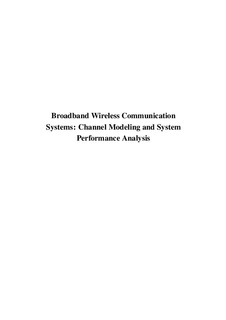| dc.description.abstract | Wideband channel modeling, which can accurately describe the most important
characteristics of wideband mobile fading channels, is essential for the design,
evaluation, and optimization of broadband wireless communication systems. In the
field of wideband channel modeling, the tradeoff between the prediction accuracy
and simulation efficiency has to be taken into account. On one hand, channel models
should be as accurate as possible. On the other hand, channel models are supposed
to be simple and easy to put into use. There are several commonly used approaches
to channel modeling, e.g., measurement-based channel modeling and deterministic
channel modeling. Both methods are efficient in capturing the fading behavior
of real-world wireless channels. However, the resulting channel models are only
valid for the specific environments as those where the measurements were carried
out or the ray-tracing scenario was considered. Moreover, these methods are quite
time consuming with high computational cost. Alternatively, the geometry-based
stochastic channel modeling approach can be employed to model wideband mobile
fading channels. The most attractive feature of this method is that the derived
channel models are able to predict fading behavior for various propagation environments,
and meanwhile they can be easily implemented. Thus, the dissertation
will complete the wideband channel modeling task by adopt the geometry-based
stochastic approach.
In the dissertation, several geometry-based channel models are proposed for
both outdoor and indoor propagation scenarios. The significance of the work lies in
the fact that it develops channel models under more realistic propagation conditions
which have seldom been considered, such as for non-isotropic scattering environxi
ments and mobile-to-mobile (M2M) fading channels. In addition, the proposed
channel models remove the scarcity that proper geometry-based channel models
are missing for indoor environments. The most important statistical properties
of the developed channel models including their temporal autocorrelation function
(ACF), the two-dimensional (2D) space cross-correlation function (CCF), and the
frequency correlation function (FCF) are analyzed. Furthermore, efficient channel
simulators with low realization expenditure are obtained. Finally, the validity of the
proposed channel models is demonstrated by comparing their analytical channel
statistics with the empirical ones measured from real world channels.
Besides the work in the field of wideband channel modeling, another part of
the dissertation is dedicated to investigate the performance of SISO1 orthogonal
frequency division multiplexing (OFDM) broadband communication systems and
space-time (ST) coded MIMO2 OFDM broadband communication systems. This
work provides a deep insight into the performance of a broadband mobile radio
communication system over realistic wideband fading channels. Analytical expressions
are derived for bit error probability (BEP) or symbol error rate (SER) of systems.
In order to confirm the correctness of the theoretical results as well as to
show the usefulness of the wideband channel models in the testing and analysis of
a broadband communication system, SISO OFDM systems and space-time coded
MIMO OFDM systems are simulated in the dissertation.
In order to improve the reliability of digital transmission over broadband wireless
radio channels, a differential super-orthogonal space-time trellis code (SOSTTC)
is designed for noncoherent communications, where neither the transmitter nor the
receiver needs the channel state information (CSI) for decoding. In addition, a new
decoding algorithm is proposed. The new algorithm has exactly the same decoding
performance as the traditional one. However, it is superior from the standpoint of
overall computing complexity. | en_US |
